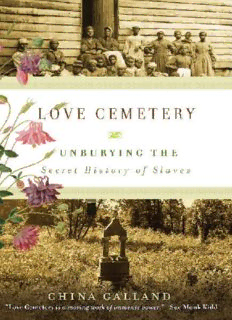
Love Cemetery: Unburying the Secret History of Slaves PDF
Preview Love Cemetery: Unburying the Secret History of Slaves
LOVE CEMETERY UNBURYING THE SECRET HISTORY OF SLAVES ��� CHINA GALLAND To my husband, Corey Fischer Photo of ”Keepers of Love ” here “The Keepers of Love.” Nuthel Britton (left) and Dorris Vittatoe (right) in front of Ohio Taylor headstone. Oil on canvas by Janet McKenzie. �Con�te�nts Prologue 1 ONE Getting into Love Cemetery 9 TWO How We Got to Love 27 THREE The First Cleanup of Love Cemetery 49 FOUR Borderlands, Badlands, and the Neutral Ground 69 FIVE “Guide Me Over” 105 SIX The Reconsecration of Love Cemetery 135 SEVEN “You Got to Stay on Board” 151 EIGHT Shiloh 187 NINE Underneath the Surface 205 Funeral Home Records of Burials 231 Love Cemetery Burial Map and List 232 Epilogue 235 Acknowledgments 243 Notes 249 Bibliography 261 Resources 265 Credits 275 About the Author Credits Cover Copyright About the Publisher �Pro�log�ue To find a common future together, we must reconstruct our common past. —Manning Marable, The Great Wells of Democracy People said that Mrs. Newton kept Negroes in her attic, that her abandoned house was haunted. Those were rumors cir- culating in Highland Park in the mid-1950s, in the days before it became such an exclusively wealthy white township of com- fortable homes inside the city of Dallas. I was about ten when I first heard whispers of Cosette Faust Newton’s story. My return as an adult, to research her story for an article, set me off on a path that eventually led me to the story of Love Cemetery, a small, rural, African American burial ground in East Texas. Cosette named her house the “Miramar,” after her street, a few blocks from my grandparents’ home in Highland Park. The front yard of the Miramar was surrounded by a barbed-wire- topped chain-link fence. Heavy jail-bar doors and barred win- dows hung throughout the house, inside and out, and were clearly visible from the street. The rest of the block was filled 2 Prologue with large, well-landscaped homes.1 Instead of a neatly trimmed lawn like her neighbors’, Cosette had scattered thirteen open red-and-white metal umbrellas, anchored in concrete blocks, around the front yard. As a finishing touch, she had hand-let- tered a sign stuck in the front yard that read: “For Sale to Ne- groes Only.” When I was sixteen, I finally worked up the nerve to try to sneak in and up to the third-floor attic, where she supposedly kept Ne- groes imprisoned, to see if there were still any chains there. Just as my girlfriend, my accomplice of the moment, and I started up the third-floor stairs, we heard footsteps. We froze, convinced that the house was really haunted. But when we turned around, we saw two uniformed Highland Park police officers. We were arrested and taken down to the station and booked on charges of trespassing. My mother came and bailed us out. Cosette pressed charges. We made our court appearance and escaped punish- ment by swearing that we would never again go in the Miramar. I kept the promise I’d made to the judge that late summer day in Dallas and forgot about the Miramar until I was an adult, a writer living across the country. Then, one night, a poem I was reading, called “Abandoned Places,” brought that house back to me—that battered, abandoned, bizarre place out of my child- hood.2 I went back to investigate, discovered the other side of the story, and wrote about it.3 It wasn’t a ghost story; Cosette, a Ph.D., M.D., and a former Dean of Women at Southern Methodist University with half a dozen more degrees, had kept a prisoner in her attic. In a front- page story in the Dallas Morning News of July 30, 1938, was a photograph of Cosette and her African American gardener,
Description: